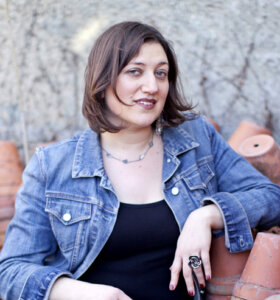How in the World Did Cuneiform Cookies Become a Thing?

Graphic by Angelie Zaslavsky
Cuneiform cookies? Yes, they are a thing. Though it has been centuries since Akkadian was spoken, cuneiform writing has had an unexpected burst of popularity as a cookie decoration. The idea started with Katy Blanchard, the Fowler/Van Santvoord Keeper of the Near Eastern Collections at the University of Pennsylvania Museum of Archaeology and Anthropology, in Philadelphia.
Next, the Mostly Dead Languages Tumblr picked up the idea, tweaking the recipe and adding additional tantalizing images of cuneiform treats. From there, the idea has swept through the world of the antiquity obsessed. The Forward’s Aviya Kushner caught up with Blanchard to ask her how the cuneiform-cookie craze started.
Aviya Kushner: How did you come up with the idea of baking cuneiform cookies?
Katy Blanchard: For some reason, I just looked down one day and thought they looked like gingerbread cookies. I thought this a long time before I made them. I simply wasn’t sure if it would work. When you do incise any type of sign into them, would they bake over and become just tasty, and not fun at the same time? Then one year they advertised a baking contest at the holiday party, and I knew this was my chance to try it out.
What is the resonance of making a mostly dead form of writing come alive in the kitchen?
I don’t read cuneiform, but I work with it daily. I know enough signs to know which way is up on bricks and tablets, for when I put them on display. We have an entire department at the museum that reads it, so I have the luxury of just barely working with the language aspect. And for me, it was making my colleagues at the museum really see that tablets are fun. It was hard to find a series of small signs I could actually reproduce, so my tablets didn’t really “say” anything. But it was the idea that people would see the cookies and simply realize that cuneiform is fun — that a dead language was still part of my life, and now it was part of theirs. I will admit that the cuneiform readers tried to read them all, which gave me great delight.
Do you get lots of fan mail? What has been your favorite response so far?
Not fan mail — this is actually the first instance of anyone asking me personally about it. But when our social media person pushed the article out on Facebook, I was able to see it shared so many times, that so many other people thought it was fun. I had friends from all over the world, from all parts of my life, tell me that someone in their department had shared the blog post, wanting to do it for their holiday party. And I saw people really make some spectacular cookies with such detailed writing that I was really happy that I inspired it.
Anything else you’d like to share about cuneiform?
I suppose it simply comes down to this: We have an amazing collection here at the museum, a collection that often inspires the people it works with. I’m incredibly lucky to work with amazing objects from amazing cultures. And not everyone gets a chance to work with this material and have it be part of their everyday life. So I wanted to give other people a chance to share it. For me it wasn’t just for the language, but for the cookies, that was what made it fun. If it’s cuneiform cookies, or a brownie ziggurat, or I recently cross-stitched our famous bull-headed lyre from Ur: I want these things to be part of everyone’s everyday life.
If you’re looking for a cuneiform tutorial so that the cuneiform cookies actually say something, The Oriental Institute of the University of Chicago offers an eight-week course, “Introduction to Sumerian Cuneiform,” available both online and in Chicago. The next online class starts on October 3, and the next in-person class starts on October 6. The registration deadline is September 19. For details, go to the university’s website, oi.uchicago.edu.

















